Europe · Greece · Regions · Western Europe
The perfect Santorini experience
Santorini is where the alluring beauty of mother nature invites you to the realm of an iconic paradise. This Cycladic island is famously known for its unique blue and white architecture that seamlessly blends in with multi-coloured volcanic cliffs, that soar out of the turquoise sea-drowned caldera.
What sets this national treasure apart from the other Greek islands is its geological characteristics and its incredibly high cliffs, that are topped with large clusters of whitewashed buildings nestled at dazzlingly breath-taking heights. Santorini combines the most enchanting views from land or sea.
Santorini is known as the honeymooner’s haven and has also been ranked fourth on the Top 10 Travelers’ Choice Awards as one of the most iconic islands in the world. With its reputation for stunning panoramas, unique sensational sunsets, and volcanic-sand beaches, it’s hardly surprising the island features on so many travelers’ bucket lists.
 The making of Santorini
The picturesque archipelago of Santorini was made of lava and has changed shape many times throughout the years. Earthquakes and volcanic eruptions have shaped the island into what it is today. Santorini is largely volcanic in origin and consists of several islands aligned in a ring around a flooded caldera. The volcanic activity kept shaping the island throughout time. Between 198 BC and 1950 AD, there were an estimated 12 more volcanic eruptions. The first inhabitants of Santorini date back to the Neolithic Period, around 3000 BC. According to searches and excavations, Santorini hosted an advanced civilization, as these people lived in two and three-story houses, and had storage rooms and drainage systems. One of the must-sees, is the “Ancient Minoan Akrotiri“, a roughly 3,500-year-old Minoan town preserved in volcanic ash, located on the southern side of the island, between the village of Akrotiri and the famous Red beach. This prehistoric city is often referred to as “Pompeii of the Aegean”.
In Greece, Santorini is also known or called Thera, named in the 12th century BC, by the Dorians from Sparta who created a colony on the island; they further named it after their King Theras. It is the largest island of a small, circular archipelago, and forms the southernmost member of the Cyclades group of islands, with an area of approximately 73 km2 (28 sq mi). The capital of Santorini is Fira, and the total population consists of around 15,550 people. The perspective of the Goliath caldera and the fantastic topography of Santorini island reveals the volcanic activity that had previously occurred.
The making of Santorini
The picturesque archipelago of Santorini was made of lava and has changed shape many times throughout the years. Earthquakes and volcanic eruptions have shaped the island into what it is today. Santorini is largely volcanic in origin and consists of several islands aligned in a ring around a flooded caldera. The volcanic activity kept shaping the island throughout time. Between 198 BC and 1950 AD, there were an estimated 12 more volcanic eruptions. The first inhabitants of Santorini date back to the Neolithic Period, around 3000 BC. According to searches and excavations, Santorini hosted an advanced civilization, as these people lived in two and three-story houses, and had storage rooms and drainage systems. One of the must-sees, is the “Ancient Minoan Akrotiri“, a roughly 3,500-year-old Minoan town preserved in volcanic ash, located on the southern side of the island, between the village of Akrotiri and the famous Red beach. This prehistoric city is often referred to as “Pompeii of the Aegean”.
In Greece, Santorini is also known or called Thera, named in the 12th century BC, by the Dorians from Sparta who created a colony on the island; they further named it after their King Theras. It is the largest island of a small, circular archipelago, and forms the southernmost member of the Cyclades group of islands, with an area of approximately 73 km2 (28 sq mi). The capital of Santorini is Fira, and the total population consists of around 15,550 people. The perspective of the Goliath caldera and the fantastic topography of Santorini island reveals the volcanic activity that had previously occurred.
 How to experience the very best of Santorini
Santorini is a beach destination to only a limited extent, as many other Greek islands have more to offer in terms of beaches. If you travel to Santorini, you should stay on the caldera peaks which are the true gems of inspirational views and ambiance. The caldera stretches for 12 kilometers from Fira to Oia. Oia is the best-known village but also the most crowded. We therefore recommend combining Imerovigli and Oia for the perfect stay on Santorini. Ideally, it would be best to plan at least a 5 night stay to experience Santorini’s true beauty.
How to experience the very best of Santorini
Santorini is a beach destination to only a limited extent, as many other Greek islands have more to offer in terms of beaches. If you travel to Santorini, you should stay on the caldera peaks which are the true gems of inspirational views and ambiance. The caldera stretches for 12 kilometers from Fira to Oia. Oia is the best-known village but also the most crowded. We therefore recommend combining Imerovigli and Oia for the perfect stay on Santorini. Ideally, it would be best to plan at least a 5 night stay to experience Santorini’s true beauty.
 Introducing the two locations that show you the island’s true beauty
Your magical journey starts in Imerovigli. The village is located at the highest point of the caldera, around 350 meters above sea level. Here you will enjoy the panoramic breath-taking views, and it is also the best location to experience the captivating famous sunsets on the island. Especially in the peak of summer, the island is overcrowded with tourists visiting for a day from the passing-by cruise ships. However, most of the crowds are drawn to Oia. Imerovigli remains a quiet and contemplative village with authentic elegance and charm even in summer. You will also find some of the finest restaurants, which offer traditional Greek cuisine, with a combination of gourmet dining options and the most panoramic views.
Introducing the two locations that show you the island’s true beauty
Your magical journey starts in Imerovigli. The village is located at the highest point of the caldera, around 350 meters above sea level. Here you will enjoy the panoramic breath-taking views, and it is also the best location to experience the captivating famous sunsets on the island. Especially in the peak of summer, the island is overcrowded with tourists visiting for a day from the passing-by cruise ships. However, most of the crowds are drawn to Oia. Imerovigli remains a quiet and contemplative village with authentic elegance and charm even in summer. You will also find some of the finest restaurants, which offer traditional Greek cuisine, with a combination of gourmet dining options and the most panoramic views.
 Grace Hotel in Imerovigli, Santorini
One of the best hotels in Imerovigli is the Grace Santorini, which is a picturesque sanctuary perched above the Aegean Sea. With only 21 rooms, it is located at the bottom of the village and is home to Santorini’s most emblematic views. The luxurious rooms, suites, and villas, embrace Santorini’s sensual sophistication and seaside splendor, and come with expansive indoor-outdoor spaces featuring heated plunge pools opening to sweeping views of Santorini’s emblematic caldera. Thus, the hotel offers the ideal setting to enjoy your magical stay on the island. It starts with breakfast with Champagne and continues with a dive in the caldera’s largest infinity pool. From the moment you check-in, you are taken on a memorable journey of discovery – every morning, the breakfast changes, and every evening you find a refined goodnight greeting.
Grace Hotel in Imerovigli, Santorini
One of the best hotels in Imerovigli is the Grace Santorini, which is a picturesque sanctuary perched above the Aegean Sea. With only 21 rooms, it is located at the bottom of the village and is home to Santorini’s most emblematic views. The luxurious rooms, suites, and villas, embrace Santorini’s sensual sophistication and seaside splendor, and come with expansive indoor-outdoor spaces featuring heated plunge pools opening to sweeping views of Santorini’s emblematic caldera. Thus, the hotel offers the ideal setting to enjoy your magical stay on the island. It starts with breakfast with Champagne and continues with a dive in the caldera’s largest infinity pool. From the moment you check-in, you are taken on a memorable journey of discovery – every morning, the breakfast changes, and every evening you find a refined goodnight greeting.
 Hiking to Oia
After 2-3 nights in Grace Santorini, it is time to move to Oia. Instead of being chauffeured to Oia in 15 minutes by car, we suggest you change hotels by taking a hike. The distance is 9 kilometers, and you need around 2 hours – depending on how many photos stops you make on the route – and there are many beautiful stops along the way. The hiking path starts right at the hotel and takes you to the center of Oia. Hiking shoes are recommended, as the path is partly unpaved and includes some uphills. Generally, it is recommended to hike to Oia as Imerovigli is much higher. Also, you should start before 9 a.m. or from 4 p.m. to avoid the midday sun. The hiking trail is numbered “9” and is very well signposted. Nevertheless, only a few tourists know the way or are aware of this option of changing hotels. In the meantime, your luggage will, of course, be transferred for you to the next hotel by car.
Hiking to Oia
After 2-3 nights in Grace Santorini, it is time to move to Oia. Instead of being chauffeured to Oia in 15 minutes by car, we suggest you change hotels by taking a hike. The distance is 9 kilometers, and you need around 2 hours – depending on how many photos stops you make on the route – and there are many beautiful stops along the way. The hiking path starts right at the hotel and takes you to the center of Oia. Hiking shoes are recommended, as the path is partly unpaved and includes some uphills. Generally, it is recommended to hike to Oia as Imerovigli is much higher. Also, you should start before 9 a.m. or from 4 p.m. to avoid the midday sun. The hiking trail is numbered “9” and is very well signposted. Nevertheless, only a few tourists know the way or are aware of this option of changing hotels. In the meantime, your luggage will, of course, be transferred for you to the next hotel by car.
 Oia – a truly magical place
Since Oia is a tourist magnet, most of the island’s luxury hotels can be found here. For this combination, we propose two hotels, which can be ideally combined with the Grace Santorini. Spend at least two nights in Oia to explore the magic and beauty of the village. A must-try is the wine, Santorini is famous for its worldwide exportation of wine. Winemaking goes back to the Roman period, and wine remains one of the major local products of the island.
The idyllic village of Oia, with its white houses and blue church domes, situated at the top of an impressive rock, offers an entrancing view of the Palia and New Kameni volcanos. Wander in the narrow alleys and footpaths through traditional architecture to find countless art galleries and taverns. Oia also has the most spellbinding views and sunsets along with the most evocative atmosphere.
Oia – a truly magical place
Since Oia is a tourist magnet, most of the island’s luxury hotels can be found here. For this combination, we propose two hotels, which can be ideally combined with the Grace Santorini. Spend at least two nights in Oia to explore the magic and beauty of the village. A must-try is the wine, Santorini is famous for its worldwide exportation of wine. Winemaking goes back to the Roman period, and wine remains one of the major local products of the island.
The idyllic village of Oia, with its white houses and blue church domes, situated at the top of an impressive rock, offers an entrancing view of the Palia and New Kameni volcanos. Wander in the narrow alleys and footpaths through traditional architecture to find countless art galleries and taverns. Oia also has the most spellbinding views and sunsets along with the most evocative atmosphere.
 Canaves Suites Oia
A top choice on the island is the Canaves Oia Suites, which is still completely family-owned and is now run by the younger generation. This is also noticeable because if you want lifestyle a la Nikki Beach or Buddha Bar, you’ve come to the right place. The renovated luxury suites offer the ultimate in modern facilities and stunning views to the caldera and the Aegean Sea, with spacious living areas and private plunge pools. Ensuring that your relaxation is complete, Canaves Oia Suites offers you the best when it comes to lounging by the pool. Take in endless views of the caldera and dive into the shimmering pool surrounded by sapphire waters. Canaves Oia Suites is also one of the few hotels that has an elevator to avoid the numerous steps.
Canaves Suites Oia
A top choice on the island is the Canaves Oia Suites, which is still completely family-owned and is now run by the younger generation. This is also noticeable because if you want lifestyle a la Nikki Beach or Buddha Bar, you’ve come to the right place. The renovated luxury suites offer the ultimate in modern facilities and stunning views to the caldera and the Aegean Sea, with spacious living areas and private plunge pools. Ensuring that your relaxation is complete, Canaves Oia Suites offers you the best when it comes to lounging by the pool. Take in endless views of the caldera and dive into the shimmering pool surrounded by sapphire waters. Canaves Oia Suites is also one of the few hotels that has an elevator to avoid the numerous steps.
 Mystique Hotel
The Mystique Hotel is part of The Luxury Collection by Marriott and is located at the entrance to Oia. If you are looking for peace and privacy, and awe-inspiring views, then the Mystique Hotel should be your choice. The 41 suites and villas are all designed using Cycladic architecture, where gentle curves and sculpted arches blend with a muted colour palette and light-enhancing spaces. Many of the suites have large terraces offering panoramic views to the caldera with open-air dining areas and private outdoor Jacuzzis. While the villas have vast terraces with hydromassage infinity pools, outdoor Jacuzzis, sunbeds, and open-air dining areas offering captivating views to the caldera.
The fitness room offers a panoramic view of the sea, which further entices that additional motivation and inspiration to exercise. The Charisma Restaurant serves Mediterranean specialties in a relaxing ambiance with panoramic views, while the Asea Restaurant, is inspired by Asia and the Sea, and showcases the best of Japanese gastronomic culture, in a dreamscape of unique infinity views to the deep blue sea.
Mystique Hotel
The Mystique Hotel is part of The Luxury Collection by Marriott and is located at the entrance to Oia. If you are looking for peace and privacy, and awe-inspiring views, then the Mystique Hotel should be your choice. The 41 suites and villas are all designed using Cycladic architecture, where gentle curves and sculpted arches blend with a muted colour palette and light-enhancing spaces. Many of the suites have large terraces offering panoramic views to the caldera with open-air dining areas and private outdoor Jacuzzis. While the villas have vast terraces with hydromassage infinity pools, outdoor Jacuzzis, sunbeds, and open-air dining areas offering captivating views to the caldera.
The fitness room offers a panoramic view of the sea, which further entices that additional motivation and inspiration to exercise. The Charisma Restaurant serves Mediterranean specialties in a relaxing ambiance with panoramic views, while the Asea Restaurant, is inspired by Asia and the Sea, and showcases the best of Japanese gastronomic culture, in a dreamscape of unique infinity views to the deep blue sea.
 Santorini is always worth a visit. Regardless of whether you have already visited the island or you are planning to visit for the first time – the combination we have proposed is suitable and recommended for all visitors.
Guido Graf is Founder of Privateupgrades. Privateupgrades is a global luxury travel club with over 20 years of experience in luxury hotels, ensuring exclusive VIP privileges like upgrades, free breakfast, free nights, rate discounts, free airport transfers, free massages and much more.
If you would like to be a guest blogger on A Luxury Travel Blog in order to raise your profile, please contact us.
Santorini is always worth a visit. Regardless of whether you have already visited the island or you are planning to visit for the first time – the combination we have proposed is suitable and recommended for all visitors.
Guido Graf is Founder of Privateupgrades. Privateupgrades is a global luxury travel club with over 20 years of experience in luxury hotels, ensuring exclusive VIP privileges like upgrades, free breakfast, free nights, rate discounts, free airport transfers, free massages and much more.
If you would like to be a guest blogger on A Luxury Travel Blog in order to raise your profile, please contact us.
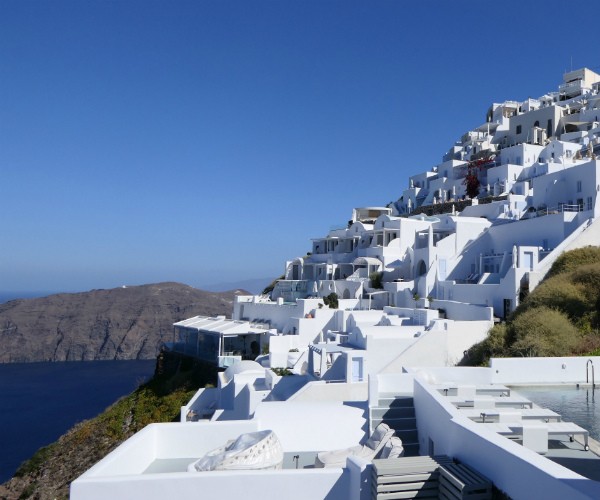 The making of Santorini
The picturesque archipelago of Santorini was made of lava and has changed shape many times throughout the years. Earthquakes and volcanic eruptions have shaped the island into what it is today. Santorini is largely volcanic in origin and consists of several islands aligned in a ring around a flooded caldera. The volcanic activity kept shaping the island throughout time. Between 198 BC and 1950 AD, there were an estimated 12 more volcanic eruptions. The first inhabitants of Santorini date back to the Neolithic Period, around 3000 BC. According to searches and excavations, Santorini hosted an advanced civilization, as these people lived in two and three-story houses, and had storage rooms and drainage systems. One of the must-sees, is the “Ancient Minoan Akrotiri“, a roughly 3,500-year-old Minoan town preserved in volcanic ash, located on the southern side of the island, between the village of Akrotiri and the famous Red beach. This prehistoric city is often referred to as “Pompeii of the Aegean”.
In Greece, Santorini is also known or called Thera, named in the 12th century BC, by the Dorians from Sparta who created a colony on the island; they further named it after their King Theras. It is the largest island of a small, circular archipelago, and forms the southernmost member of the Cyclades group of islands, with an area of approximately 73 km2 (28 sq mi). The capital of Santorini is Fira, and the total population consists of around 15,550 people. The perspective of the Goliath caldera and the fantastic topography of Santorini island reveals the volcanic activity that had previously occurred.
The making of Santorini
The picturesque archipelago of Santorini was made of lava and has changed shape many times throughout the years. Earthquakes and volcanic eruptions have shaped the island into what it is today. Santorini is largely volcanic in origin and consists of several islands aligned in a ring around a flooded caldera. The volcanic activity kept shaping the island throughout time. Between 198 BC and 1950 AD, there were an estimated 12 more volcanic eruptions. The first inhabitants of Santorini date back to the Neolithic Period, around 3000 BC. According to searches and excavations, Santorini hosted an advanced civilization, as these people lived in two and three-story houses, and had storage rooms and drainage systems. One of the must-sees, is the “Ancient Minoan Akrotiri“, a roughly 3,500-year-old Minoan town preserved in volcanic ash, located on the southern side of the island, between the village of Akrotiri and the famous Red beach. This prehistoric city is often referred to as “Pompeii of the Aegean”.
In Greece, Santorini is also known or called Thera, named in the 12th century BC, by the Dorians from Sparta who created a colony on the island; they further named it after their King Theras. It is the largest island of a small, circular archipelago, and forms the southernmost member of the Cyclades group of islands, with an area of approximately 73 km2 (28 sq mi). The capital of Santorini is Fira, and the total population consists of around 15,550 people. The perspective of the Goliath caldera and the fantastic topography of Santorini island reveals the volcanic activity that had previously occurred.
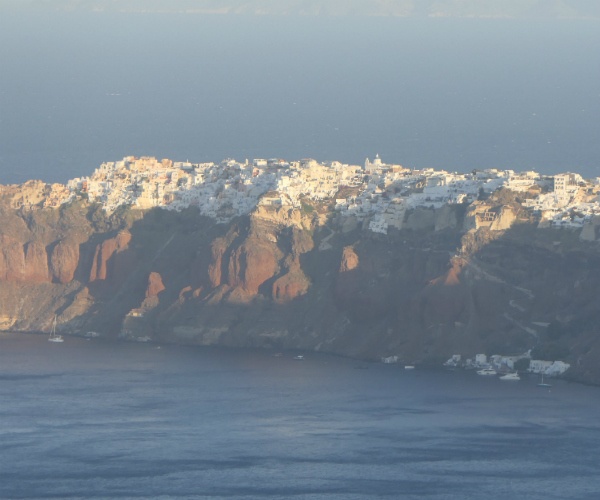 How to experience the very best of Santorini
Santorini is a beach destination to only a limited extent, as many other Greek islands have more to offer in terms of beaches. If you travel to Santorini, you should stay on the caldera peaks which are the true gems of inspirational views and ambiance. The caldera stretches for 12 kilometers from Fira to Oia. Oia is the best-known village but also the most crowded. We therefore recommend combining Imerovigli and Oia for the perfect stay on Santorini. Ideally, it would be best to plan at least a 5 night stay to experience Santorini’s true beauty.
How to experience the very best of Santorini
Santorini is a beach destination to only a limited extent, as many other Greek islands have more to offer in terms of beaches. If you travel to Santorini, you should stay on the caldera peaks which are the true gems of inspirational views and ambiance. The caldera stretches for 12 kilometers from Fira to Oia. Oia is the best-known village but also the most crowded. We therefore recommend combining Imerovigli and Oia for the perfect stay on Santorini. Ideally, it would be best to plan at least a 5 night stay to experience Santorini’s true beauty.
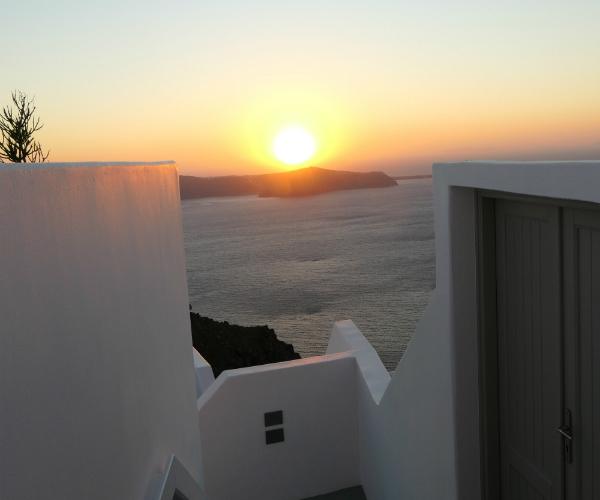 Introducing the two locations that show you the island’s true beauty
Your magical journey starts in Imerovigli. The village is located at the highest point of the caldera, around 350 meters above sea level. Here you will enjoy the panoramic breath-taking views, and it is also the best location to experience the captivating famous sunsets on the island. Especially in the peak of summer, the island is overcrowded with tourists visiting for a day from the passing-by cruise ships. However, most of the crowds are drawn to Oia. Imerovigli remains a quiet and contemplative village with authentic elegance and charm even in summer. You will also find some of the finest restaurants, which offer traditional Greek cuisine, with a combination of gourmet dining options and the most panoramic views.
Introducing the two locations that show you the island’s true beauty
Your magical journey starts in Imerovigli. The village is located at the highest point of the caldera, around 350 meters above sea level. Here you will enjoy the panoramic breath-taking views, and it is also the best location to experience the captivating famous sunsets on the island. Especially in the peak of summer, the island is overcrowded with tourists visiting for a day from the passing-by cruise ships. However, most of the crowds are drawn to Oia. Imerovigli remains a quiet and contemplative village with authentic elegance and charm even in summer. You will also find some of the finest restaurants, which offer traditional Greek cuisine, with a combination of gourmet dining options and the most panoramic views.
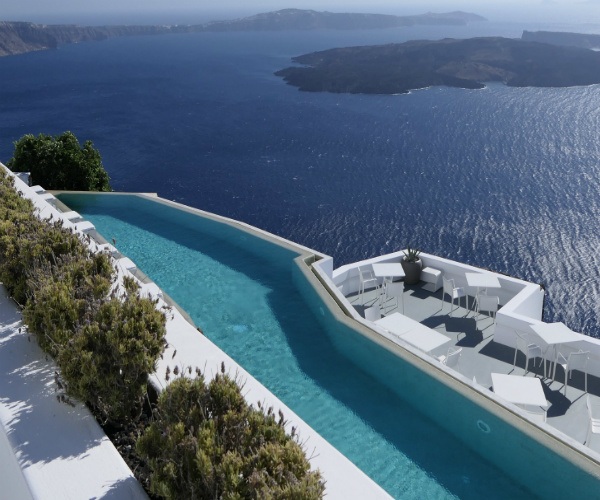 Grace Hotel in Imerovigli, Santorini
One of the best hotels in Imerovigli is the Grace Santorini, which is a picturesque sanctuary perched above the Aegean Sea. With only 21 rooms, it is located at the bottom of the village and is home to Santorini’s most emblematic views. The luxurious rooms, suites, and villas, embrace Santorini’s sensual sophistication and seaside splendor, and come with expansive indoor-outdoor spaces featuring heated plunge pools opening to sweeping views of Santorini’s emblematic caldera. Thus, the hotel offers the ideal setting to enjoy your magical stay on the island. It starts with breakfast with Champagne and continues with a dive in the caldera’s largest infinity pool. From the moment you check-in, you are taken on a memorable journey of discovery – every morning, the breakfast changes, and every evening you find a refined goodnight greeting.
Grace Hotel in Imerovigli, Santorini
One of the best hotels in Imerovigli is the Grace Santorini, which is a picturesque sanctuary perched above the Aegean Sea. With only 21 rooms, it is located at the bottom of the village and is home to Santorini’s most emblematic views. The luxurious rooms, suites, and villas, embrace Santorini’s sensual sophistication and seaside splendor, and come with expansive indoor-outdoor spaces featuring heated plunge pools opening to sweeping views of Santorini’s emblematic caldera. Thus, the hotel offers the ideal setting to enjoy your magical stay on the island. It starts with breakfast with Champagne and continues with a dive in the caldera’s largest infinity pool. From the moment you check-in, you are taken on a memorable journey of discovery – every morning, the breakfast changes, and every evening you find a refined goodnight greeting.
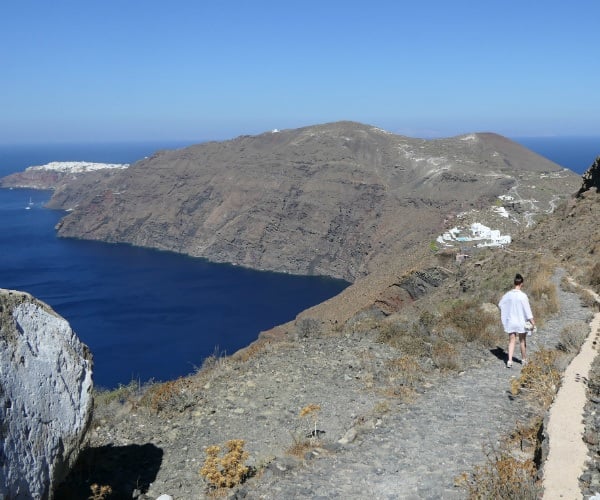 Hiking to Oia
After 2-3 nights in Grace Santorini, it is time to move to Oia. Instead of being chauffeured to Oia in 15 minutes by car, we suggest you change hotels by taking a hike. The distance is 9 kilometers, and you need around 2 hours – depending on how many photos stops you make on the route – and there are many beautiful stops along the way. The hiking path starts right at the hotel and takes you to the center of Oia. Hiking shoes are recommended, as the path is partly unpaved and includes some uphills. Generally, it is recommended to hike to Oia as Imerovigli is much higher. Also, you should start before 9 a.m. or from 4 p.m. to avoid the midday sun. The hiking trail is numbered “9” and is very well signposted. Nevertheless, only a few tourists know the way or are aware of this option of changing hotels. In the meantime, your luggage will, of course, be transferred for you to the next hotel by car.
Hiking to Oia
After 2-3 nights in Grace Santorini, it is time to move to Oia. Instead of being chauffeured to Oia in 15 minutes by car, we suggest you change hotels by taking a hike. The distance is 9 kilometers, and you need around 2 hours – depending on how many photos stops you make on the route – and there are many beautiful stops along the way. The hiking path starts right at the hotel and takes you to the center of Oia. Hiking shoes are recommended, as the path is partly unpaved and includes some uphills. Generally, it is recommended to hike to Oia as Imerovigli is much higher. Also, you should start before 9 a.m. or from 4 p.m. to avoid the midday sun. The hiking trail is numbered “9” and is very well signposted. Nevertheless, only a few tourists know the way or are aware of this option of changing hotels. In the meantime, your luggage will, of course, be transferred for you to the next hotel by car.
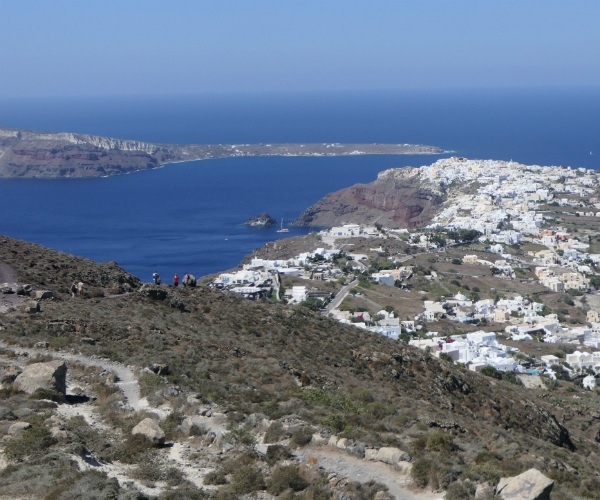 Oia – a truly magical place
Since Oia is a tourist magnet, most of the island’s luxury hotels can be found here. For this combination, we propose two hotels, which can be ideally combined with the Grace Santorini. Spend at least two nights in Oia to explore the magic and beauty of the village. A must-try is the wine, Santorini is famous for its worldwide exportation of wine. Winemaking goes back to the Roman period, and wine remains one of the major local products of the island.
The idyllic village of Oia, with its white houses and blue church domes, situated at the top of an impressive rock, offers an entrancing view of the Palia and New Kameni volcanos. Wander in the narrow alleys and footpaths through traditional architecture to find countless art galleries and taverns. Oia also has the most spellbinding views and sunsets along with the most evocative atmosphere.
Oia – a truly magical place
Since Oia is a tourist magnet, most of the island’s luxury hotels can be found here. For this combination, we propose two hotels, which can be ideally combined with the Grace Santorini. Spend at least two nights in Oia to explore the magic and beauty of the village. A must-try is the wine, Santorini is famous for its worldwide exportation of wine. Winemaking goes back to the Roman period, and wine remains one of the major local products of the island.
The idyllic village of Oia, with its white houses and blue church domes, situated at the top of an impressive rock, offers an entrancing view of the Palia and New Kameni volcanos. Wander in the narrow alleys and footpaths through traditional architecture to find countless art galleries and taverns. Oia also has the most spellbinding views and sunsets along with the most evocative atmosphere.
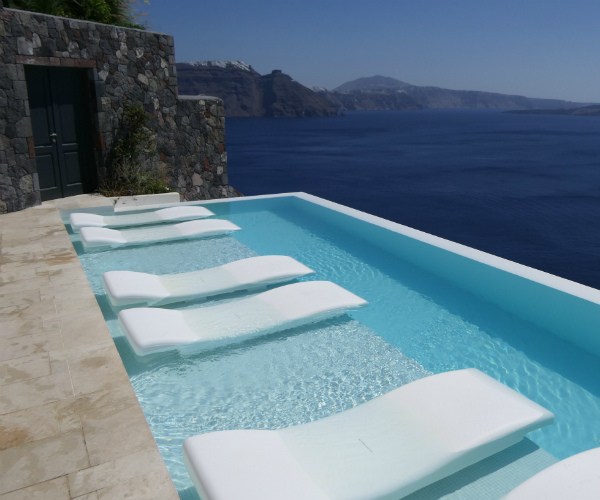 Canaves Suites Oia
A top choice on the island is the Canaves Oia Suites, which is still completely family-owned and is now run by the younger generation. This is also noticeable because if you want lifestyle a la Nikki Beach or Buddha Bar, you’ve come to the right place. The renovated luxury suites offer the ultimate in modern facilities and stunning views to the caldera and the Aegean Sea, with spacious living areas and private plunge pools. Ensuring that your relaxation is complete, Canaves Oia Suites offers you the best when it comes to lounging by the pool. Take in endless views of the caldera and dive into the shimmering pool surrounded by sapphire waters. Canaves Oia Suites is also one of the few hotels that has an elevator to avoid the numerous steps.
Canaves Suites Oia
A top choice on the island is the Canaves Oia Suites, which is still completely family-owned and is now run by the younger generation. This is also noticeable because if you want lifestyle a la Nikki Beach or Buddha Bar, you’ve come to the right place. The renovated luxury suites offer the ultimate in modern facilities and stunning views to the caldera and the Aegean Sea, with spacious living areas and private plunge pools. Ensuring that your relaxation is complete, Canaves Oia Suites offers you the best when it comes to lounging by the pool. Take in endless views of the caldera and dive into the shimmering pool surrounded by sapphire waters. Canaves Oia Suites is also one of the few hotels that has an elevator to avoid the numerous steps.
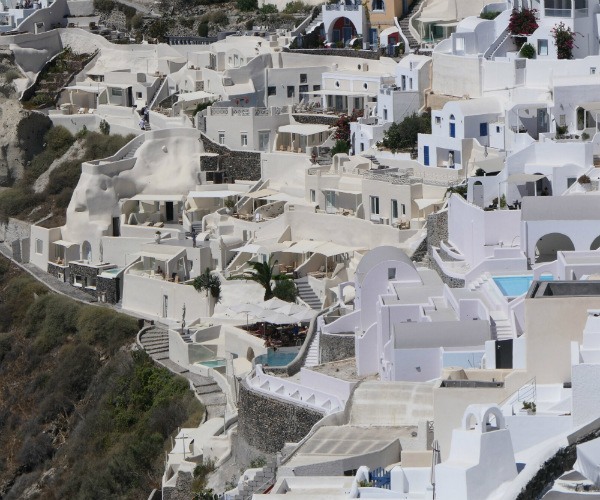 Mystique Hotel
The Mystique Hotel is part of The Luxury Collection by Marriott and is located at the entrance to Oia. If you are looking for peace and privacy, and awe-inspiring views, then the Mystique Hotel should be your choice. The 41 suites and villas are all designed using Cycladic architecture, where gentle curves and sculpted arches blend with a muted colour palette and light-enhancing spaces. Many of the suites have large terraces offering panoramic views to the caldera with open-air dining areas and private outdoor Jacuzzis. While the villas have vast terraces with hydromassage infinity pools, outdoor Jacuzzis, sunbeds, and open-air dining areas offering captivating views to the caldera.
The fitness room offers a panoramic view of the sea, which further entices that additional motivation and inspiration to exercise. The Charisma Restaurant serves Mediterranean specialties in a relaxing ambiance with panoramic views, while the Asea Restaurant, is inspired by Asia and the Sea, and showcases the best of Japanese gastronomic culture, in a dreamscape of unique infinity views to the deep blue sea.
Mystique Hotel
The Mystique Hotel is part of The Luxury Collection by Marriott and is located at the entrance to Oia. If you are looking for peace and privacy, and awe-inspiring views, then the Mystique Hotel should be your choice. The 41 suites and villas are all designed using Cycladic architecture, where gentle curves and sculpted arches blend with a muted colour palette and light-enhancing spaces. Many of the suites have large terraces offering panoramic views to the caldera with open-air dining areas and private outdoor Jacuzzis. While the villas have vast terraces with hydromassage infinity pools, outdoor Jacuzzis, sunbeds, and open-air dining areas offering captivating views to the caldera.
The fitness room offers a panoramic view of the sea, which further entices that additional motivation and inspiration to exercise. The Charisma Restaurant serves Mediterranean specialties in a relaxing ambiance with panoramic views, while the Asea Restaurant, is inspired by Asia and the Sea, and showcases the best of Japanese gastronomic culture, in a dreamscape of unique infinity views to the deep blue sea.
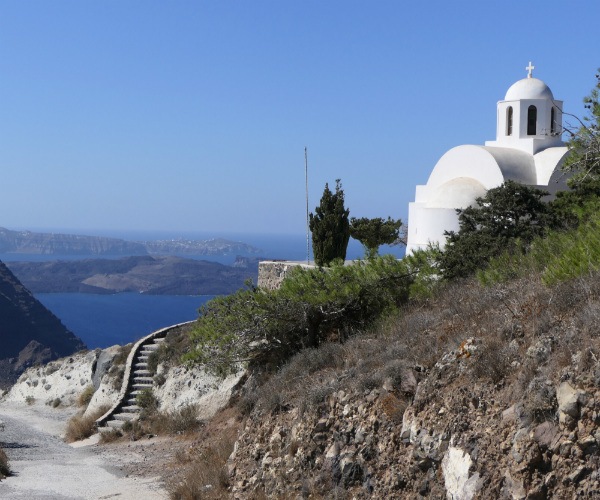 Santorini is always worth a visit. Regardless of whether you have already visited the island or you are planning to visit for the first time – the combination we have proposed is suitable and recommended for all visitors.
Guido Graf is Founder of Privateupgrades. Privateupgrades is a global luxury travel club with over 20 years of experience in luxury hotels, ensuring exclusive VIP privileges like upgrades, free breakfast, free nights, rate discounts, free airport transfers, free massages and much more.
If you would like to be a guest blogger on A Luxury Travel Blog in order to raise your profile, please contact us.
Santorini is always worth a visit. Regardless of whether you have already visited the island or you are planning to visit for the first time – the combination we have proposed is suitable and recommended for all visitors.
Guido Graf is Founder of Privateupgrades. Privateupgrades is a global luxury travel club with over 20 years of experience in luxury hotels, ensuring exclusive VIP privileges like upgrades, free breakfast, free nights, rate discounts, free airport transfers, free massages and much more.
If you would like to be a guest blogger on A Luxury Travel Blog in order to raise your profile, please contact us.Did you enjoy this article?
Receive similar content direct to your inbox.


I’ve always had mixed feelings about Santorini. Part of me has been attracted by the amazing white architecture then again it has such a reputation for being packed with tourists that it has actually put me off from travelling. Good to read this and get some helpful tips for a visit.
I have the idea of Santorini being quite a busy, heavily tourist populated destination too. I was surprised by the post and images that give it a far calmer, more spacious and quiet feel, which is really appealing. I can see why it would be so popular though, and at least it’s not tacky and over done with tourists like some parts of other places with big clubbing scenes.
Hi Dan.
This summer was an exception, and Santorini was empty (similar to Venice). That will change again in the future – therefore, our proposal will also serve to experience Santorini in all its beauty in the coming years and avoid the tourists’ stream as best as possible.
The Ancient Minoan Akrotiri city would be fascinating to see, both for the prehistoric interest and with how it’s covered in ash. It’s quite sad though to think that such an area is lost to the world. I wonder whether one day it’ll be reinvented? It holds a lot of history so that’s something I’d want to explore while I’m there. Santorini always looks beautiful, and it actually looks more peaceful than I’d imagined.
Felicity, it’s a wonderful place. For geologists, historians as well as romantics :-)
I did a double take with that first pic. It looked to me as if the whole village was covered in snow. Don’t suppose that it ever snows in Santorini?
Hello Leo, when I took the ship to Santorini and saw the island from afar, I also thought there was snow on the mountains. The closer you get, then you realize that these are all white houses. However, there are very few years when there can be light snowfall on Santorini in January and February.